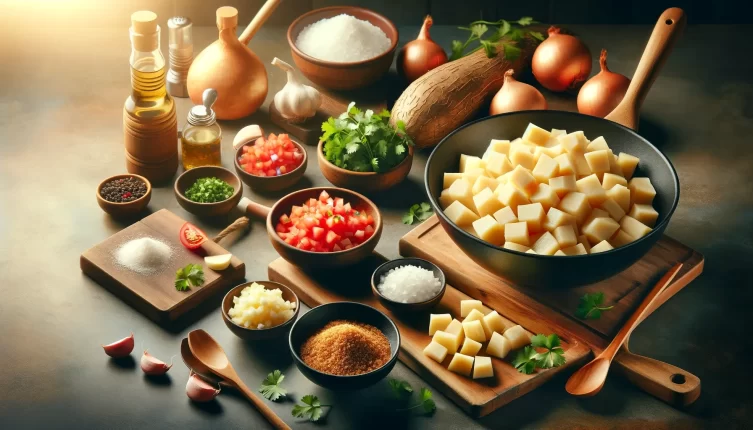From its flaky layers to customizable fillings, delve into the world of Cassasse – a delightful fusion of simplicity and flavor. Perfect for any occasion, explore the FAQs to unravel the mystery behind “What is Cassasse?”
In the realm of culinary delights, Cassasse stands out as a unique and intriguing ingredient. This article aims to unravel the mysteries surrounding Cassasse, providing you with a comprehensive guide to this exceptional element.
What is Cassasse?
Native to South America, cassava is a starchy root crop also referred to as yuca or manioc. For more than 800 million people globally, especially in tropical and subtropical areas, it’s miles an extensive supply of carbohydrates. In addition to being a very good supply of electricity and fiber, cassava additionally includes a number of vitamins and minerals, such as manganese, potassium, and nutrition C.

Understanding Cassasse
Definition and Origin
Cassasse is a term that originates from the culinary traditions of the Mediterranean, particularly in the southern regions where it has been a well-kept culinary secret for generations. The term itself has its roots in ancient dialects, signifying a special ingredient integral to traditional dishes.
Culinary Significance
Known for its versatility, Cassasse is a key component in various dishes, adding a distinctive flavor profile that elevates the overall culinary experience. Its usage extends across a spectrum of cuisines, making it a cherished ingredient for seasoned chefs and home cooks alike.
Types of Cassasse
Regional Variations
The diversity of Cassasse becomes apparent when exploring regional variations. Different locales may have their own unique twists on how this ingredient is prepared and incorporated into dishes. From savory to sweet, Cassasse finds its way into a myriad of recipes, showcasing its adaptability.
Culinary Applications
Cassasse in Savory Dishes
In savory preparations, Cassasse often takes center stage in stews, sauces, and marinades. Its robust flavor profile enhances meat-based dishes, imparting a depth of taste that lingers on the palate. Chefs across the Mediterranean have perfected the art of using Cassasse to create signature savory masterpieces.
Cassasse in Sweet Delights
On the sweeter side, Cassasse reveals a different facet of its character. Pastry chefs treasure this ingredient for its ability to add a subtle yet complex sweetness to desserts. From cakes to confections, Cassasse contributes a unique note that sets these treats apart. Read also here about Shadow Slave Wiki.
Where to Find and Purchase Cassasse
Native to South America, cassava, also referred to as yuca, is a sugary root crop. In addition to being a staple food in many parts of the world, it is also gaining popularity in the US. There are multiple avenues for locating and acquiring cassava.
Some Latin American grocery stores and farmers’ markets carry fresh cassava. It is significant to keep in mind that uncooked fresh cassava contains a toxin called linamarin, which can be risky. Before cooking, cassava needs to be peeled, chopped, and soaked in water for at least 24 hours.
Frozen cassava is a convenient option that is easily available at most grocery stores. Frozen cassava is already peeled and chopped, and it does not want to be soaked in water earlier than cooking.
Dried cassava is another alternative that may be determined at a few grocery stores. Dried cassava is normally bought in the form of flakes or granules. It may be used in a number of recipes, such as soups, stews, and bread.
How to Use Cassasse in Your Cooking
Tips for Cooking with Cassasse
Incorporating Cassasse into your culinary repertoire can be a game-changer. Here are some tips to make the most of this extraordinary ingredient:
- Balance is Key: While Cassasse can be bold, finding the right balance is crucial. Experiment with small quantities to understand its impact on your dish.
- Pairing Possibilities: Cassasse pairs exceptionally well with certain herbs and spices. Consider experimenting with complementary flavors to enhance your recipes.
- Exploring Culinary Combinations: Don’t limit Cassasse to a specific cuisine. Embrace its versatility by exploring various culinary traditions and incorporating it creatively.
Where to Find Cassasse
Sourcing Quality Cassasse
Finding high-quality Cassasse can elevate your culinary creations. Local markets in Mediterranean regions often feature authentic sources, but in the age of global connectivity, online platforms can also be treasure troves for acquiring this unique ingredient.
Cassasse in Popular Culture
Influences in Modern Cuisine
As culinary boundaries continue to blur, Cassasse is gradually making its mark in modern gastronomy. Renowned chefs worldwide are incorporating this ingredient into their innovative dishes, sparking a new wave of appreciation for its rich heritage.
Health Benefits of Consuming Cassava
Cassava may be a wholesome part of a balanced food plan. It is a superb supply of strength, in addition to fiber, which will let you feel complete and happy. It is also a very good source of nutrients and minerals, along with vitamin C, potassium, and magnesium.
Cassava has been linked to a number of health benefits, including:
- Improved digestion: The fiber in cassava can help to improve digestion and regularity.
- Weight management: The fiber in cassava can also help you feel full and satisfied, which can help you to eat less.
- Reduced risk of chronic diseases: The antioxidants in cassava may help to protect against chronic diseases such as heart disease, cancer, and stroke.
- Improved mental health: Cassava is a good source of B vitamins, which are important for brain health.
Cassava is a versatile food that can be eaten in many ways. It can be boiled, baked, fried, or roasted. It can also be used to make flour, starch, and tapioca.

Final Thoughts
In conclusion, Cassasse transcends being just an ingredient; it is a culinary journey waiting to be explored. Its rich history, diverse applications, and ability to transform dishes make it a valuable asset in any kitchen. Whether you’re an aspiring chef or a seasoned culinary enthusiast, embracing Cassasse opens up a world of gastronomic possibilities.




